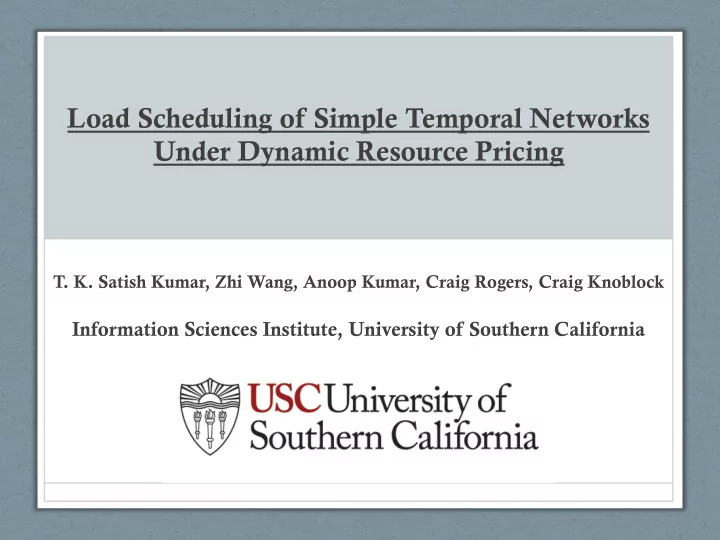

Load Scheduling of Simple Temporal Networks Under Dynamic Resource Pricing T. K. Satish Kumar, Zhi Wang, Anoop Kumar, Craig Rogers, Craig Knoblock Information Sciences Institute, University of Southern California
Executive Summary in Keywords • Simple Temporal Networks (STNs): temporal constraints between processes in scheduling problems. • Resources: like electricity, consumed by processes. • Dynamic Price: unit cost of electricity varies with time and total demand. • Polynomial-time Algorithms: for cost minimization and optimal tradeoff against makespan in many important classes of such scheduling problems.
Example: Smart Home Find a consistent schedule of minimum total cost.
Two Models of Resource Consumption • Model A: Each process P i consumes electricity at the rate of w i watts during execution. • Model B: Each process P i demands its entire energy requirement, that is, the total energy W i = w i duration(P i ) at the beginning of its execution. • Solving Model B is a little simpler. It also provides the critical combinatorial arguments useful for solving Model A .
Simple Temporal Networks/Problems
Core Combinatorial Problem Each process P i has to be activated in some interval I j , that is, the starting point of P i should be in I j . The cost for activating P i in the interval I j is W i f(I j ) . Find the best combination of intervals in which each process should be activated such that: (a) the schedule is consistent; and (b) the total cost is minimized.
Activating Process P i in Interval I j • The beginning point of P i , i.e., X s Pi , should be scheduled after the left endpoint of I j (say, L ) and before the right endpoint of I j (say, U ). • X s Pi – X 0 ≥ L and X s Pi – X 0 ≤ U .
Conflicts and Minimal Conflicts • A conflict is a set of activations (P 1 , I j1 ), (P 2 , I j2 ) … (P K , I jK ) that cannot be simultaneously achieved. • A minimal conflict is a conflict no proper subset of which is also a conflict. • A set of activations (P 1 , I j1 ), (P 2 , I j2 ) … (P K , I jK ) can be simultaneously achieved if and only if they do not contain a minimal conflict.
Bounded Minimal Conflicts The size of a minimal conflict is ≤ 2.
Example: Smart Home Find a consistent schedule of minimum total cost.
Conflict Graph The minimum weighted independent set that includes exactly one interval activation for each process corresponds to the optimal solution. Issue 1: Different from the maximum weighted independent set. Issue 2: Computing the maximum weighted independent set is NP-hard.
Solving Issue 1 A simple readjustment of weights converts the problem to a regular maximum weighted independent set problem.
Solving Issue 2 The directed graph is a POSET, that is, it is acyclic and transitive. The maximum weighted independent set is the maximum weighted antichain in a POSET. The maximum weighted antichain can be computed in polynomial time using a maxflow algorithm.
Tradeoff Against Makespan • Find a schedule that is of minimum makespan among all schedules with cost ≤ γ optimal cost. • γ is a given suboptimality factor ≥ 1. • Key Observation: makespan constraints are also simple temporal. • Do a Binary Search on makespan in the outer loop. • Solve the minimization of cost problem in the inner loop. • Optimizations lead to Quasi Binary Search.
Conjectured Tractable Classes and Negative Results Conjectured to be tractable for Model A and for concave dependency of unit price on total demand. But provably NP-hard for convex dependency of unit price on total demand.
Conclusions and Future Work • We presented a polynomial-time maxflow-based algorithm for optimally scheduling STNs with dynamic resource pricing. • Unit prices change with time but according to a piecewise constant function. • Processes demand energy requirements upfront. • Conjectured tractable classes • Unit prices have a concave dependency on total demand. • Processes consume energy at a uniform wattage. • Some NP-hard results • Unit prices have a convex dependency on total demand. • Future Work: resolve conjectures; and apply algorithms to real-world engineering domains.
Recommend
More recommend